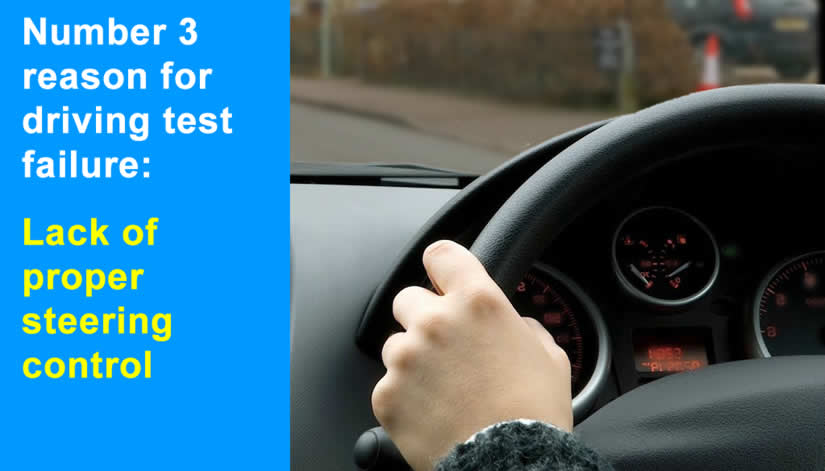During the driving test, the examiner will expect smooth steering and accurately timed steering. Any faults recorded during the test that are steering related will be marked under the ‘Control – Steering’ section of the driving test report.
Steering faults that have the potential to be hazardous to other road users are usually marked as a serious and steering faults that are hazardous to other road users or require intervention from the examiner will be marked as a dangerous fault.
To help avoid failing the test on steering related issues, this top driving test fails number 3 will explain the most common reasons why driving test candidates fail the test on steering related faults.
Not Steering Enough When Turning Left
When making a left turn into a minor road, the test candidate fails to steer enough when making the turn. This results in the test candidate’s vehicle taking up too much space in the centre of the road that they just entered, making it difficult for other vehicles who are exiting the junction and turning right.
Always observe left turns from the earliest opportunity as this will help you gauge the type of road you’re about to enter. Things to look for before making the turn are hazards that are in the road that you want to enter, such as parked vehicles. Try to assess how sharp the turn is before entering the road. Speed also effects the turn, if the turn looks sharp and the road looks narrow, slow down to an appropriate speed before making the turn. Where possible, try to follow the kerb line round to the left.
Steering too Late When Turning Left
This is where the test candidate is making a left turn, steers left too late resulting in the vehicle positioning too far to the right when entering the left turn. This is hazardous for vehicles exiting the junction.
This situation can occur when the test candidate’s vehicle speed is too fast. Always choose a suitable speed relative to the left turn. It’s best to take the turn safely and slowly rather than too fast.
Steering Around Bends
This situation occurs when the test candidate is driving around a right-hand bend at an appropriate speed but fails to apply enough steering. As a result, it causes the passenger-side wheels to mount the pavement. This is an issue that will typically result in a serious or dangerous fault if the examiner need to take control of the steering wheel.
Steering during general driving is something that takes some learner drivers longer to master than others. Some instructors use in-car markers that help learner’s in understanding the vehicle’s road position by lining up markers with external objects such as kerbs.
Steering Late on a Right Turn
During the driving test, this involves the test candidate making a right turn into a minor road. The candidate steers late and not enough, resulting in the candidate having to then excessively steer right to overcompensate. This causes the vehicle to enter the wrong side of the new road, before steering left again to correct the position.
The best method for making right turns is to use reference points. Line the centre of the road up with a reference point inside the vehicle, when you reach the reference point, steer quickly to the right. This always ensures you’ll enter the new road with a good road position.
Mounting the Pavement
Hitting the kerb is something you might be able to get away with as a (minor) fault, but mounting the pavement is not so likely. This serious or dangerous fault relates the the test candidate being asked by the examiner to pull up on the left. In doing so, the vehicle’s passenger-side wheels mount the pavement before returning to the road.
A useful method to try is once again, reference points. When parked in a good position, use a reference point inside the car to line up where the kerb visually ‘hits’ the dashboard. Mark that spot and use it as a guide for lining up your car when parking.
Passing Parked Cars
Finally, this fault involves the test candidate approaching parked cars on the left. The candidate steers late when moving round to pass the parked cars, resulting in the candidate’s vehicle getting very close to the first parked car.
Always give yourself enough time to look, assess, decide and act (LADA) on any hazard ahead. Once you’ve spotted a potential hazard (in this case the parked cars), check your mirrors and reduce your car’s speed appropriately so that you can control the vehicle safely. given any changes in the situation.
